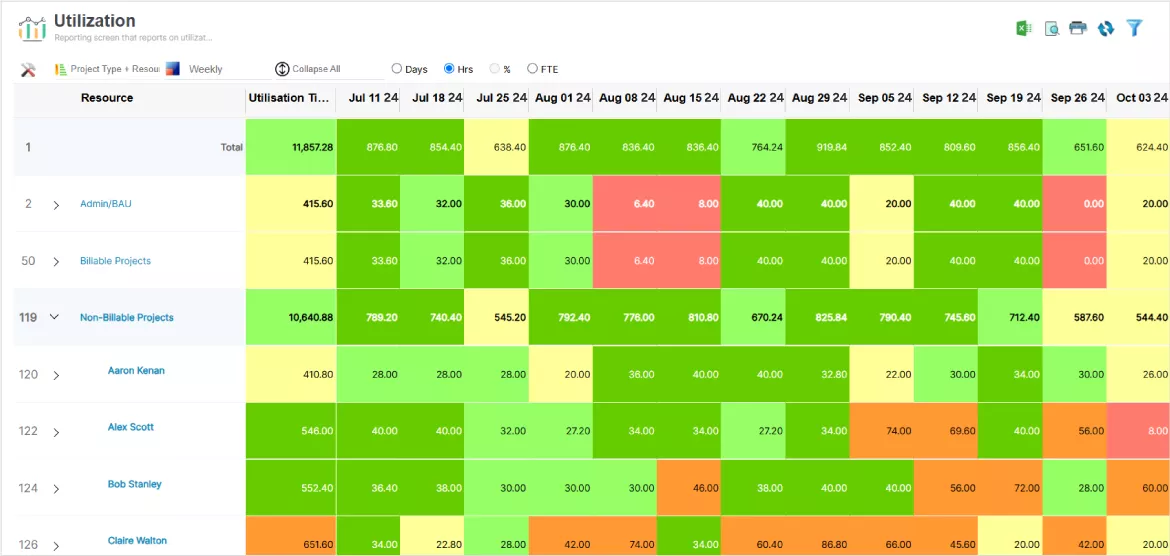According to the BLS Report, “6.9 million workers, making up 4.3% of the workforce, were employed in contingent positions as their main or only job.”
This statistic highlights the growing reliance on the on-demand workforce in today’s business environment. Organizations are turning to contingent workers to address critical challenges, such as skill shortages and unplanned attrition, which often lead to project delays, budget overruns, and compromised profitability.
By employing contingent workers, businesses can mitigate these bottlenecks without incurring additional overhead costs or extended lead times. This workforce model is particularly advantageous for project-driven organizations, enabling them to manage seasonal demands, control costs, and adapt to rapidly changing market dynamics.
In this article, we explore the benefits of employing a contingent workforce and outline the best practices to manage them effectively. To begin, let’s clarify what a contingent worker is and how they differ from traditional employees.
What is a Contingent Worker?
A contingent worker is a temporary, on-demand employee hired by an organization on a project-by-project basis. For example, if you require a voiceover artist for your videos, you can hire a freelancer on a video-to-video basis rather than keeping them as a permanent employee.
These workers enjoy flexible working hours and can work on-site or remotely as long as tasks are completed within the agreed timeframe. After fulfilling their purpose, companies can discontinue their services.
Unlike permanent employees, contingent workers have limited contractual obligations. Organizations are not required to add them to the payroll or provide benefits such as health insurance or retirement plans. They are also generally not eligible for perks, leaves, yearly appraisals, etc.
Let’s now look at how a contingent workforce is onboarded.
Contingent Workforce Onboarding
Contingent workers have become an integral part of organizational success. These professionals, hired on a project basis, bring specialized skills and flexibility to meet business needs.
Therefore, having a well-structured onboarding process is key to ensuring they assimilate with the organization seamlessly. This will enable them to understand their role, align with organizational goals, and feel valued despite their temporary status.
To start, firms must provide contingent workers with clear expectations, access to necessary tools, and any required project-specific training. They must tailor the onboarding experience to their role, ensuring they are equipped with the resources and knowledge to excel.
Further, they must be introduced to company culture, values, and mission to help foster a sense of connection and belonging. By assigning mentors or experienced team members as guides, firms can help new workers navigate organizational processes smoothly, build relationships, and adapt proactively.
Now, let us explore various types of contingent workers.
Types of a Contingent Worker
The contingent workforce falls under one of the primary categories, which is as follows:
Freelancers
A freelancer is a self-employed individual to whom tasks can be outsourced, with payment based on hours worked or deliverable quantities, depending on the nature of the job. An independent blogger is a prime example of a freelancer, where a company pays a fixed amount per word or article, as agreed upon mutually.
Unlike other contingent resources, a freelancer typically has no fixed start date or end date. A very closely related type of contingent worker to this is a gig worker. However, the difference is that a freelancer is more autonomous in terms and conditions, more specialized, and open to more specific skill-intensive tasks.
Contractor
A contractor is an individual or a group of individuals hired for a specified duration, typically to execute a multi-faceted project. The contract outlines a predetermined start and end date, ensuring clear expectations between both parties. Independent contractors provide niche skill sets essential for high-value projects requiring heavy investment and specific expertise.
For instance, constructing a new airport requires architects, designers, financiers, and other specialists. A contractor is the one who can provide you with all this expertise under one roof. This makes the contractor a reliable partner for managing the project seamlessly, ensuring all aspects are handled efficiently and within the set timelines.
Casual Earners
A casual earner is a contingent worker, similar to a freelancer. However, there is no guaranteed availability of work in the future or fixed hours of employment. A company hires casual earners only when they need contingent workers to cater to increased demand during peak seasons.
Unlike other contingent workers who may work flexible hours throughout the day, casual earners work irregular hours, mostly in shifts. Some good examples include daily-wage laborers or workers hired temporarily to handle the holiday rush in retail outlets.
Temporary Workers
A temporary worker falls between a contingent worker and a permanent employee. They receive “on-demand” work from different companies and often rely on staffing agencies or their current client to get a more permanent position. Staffing agencies also offer them more protection than other types of contingent workers.
Additionally, temporary workers are more likely to transition into a permanent role than contingent workers. For example, a graphic designer hired for a six-month marketing project works on a fixed-term basis but is not fully integrated into the company. Despite being an on-demand worker, they may transition from temporary to permanent based on their performance, skillsets, and requirements.
Read More: What is Workforce Planning, and How to Master it for Business Efficiency?
Let us now see the benefits of having contingent workers in an organization.
Benefits of Having Contingent Workers
According to the Global Contingent Workforce Management Market, the demand for on-demand resources is expected to grow to $325.7 trillion by 2028, with a 10.1% CAGR.
This figure highlights the growing importance of tapping into a contingent workforce or gig economy in the present-age business scenario.
Let’s delve into the benefits of contingent workers in detail.
Cost-effective for Short-term Assignments
When you hire a contingent workforce for short-term assignments, it helps you reduce expenses. Unlike regular employees, firms don’t need to manage and bear their overhead costs or provide them with other employee benefits like health insurance, perks, paid time off, etc. Therefore, a contingent workforce helps firms complete projects faster and in a cost-efficient manner.
Read More: Reduce Resourcing Cost by 10-30% with Modern Resource Management Solution
Maximizes Productive Resource Utilization
As contingent workers are hired for specific, short-term needs, their utilization rate can be optimized and set close to 100%. Typically employed on an hourly basis, these contingent workers focus on delivering results within defined timelines. This structure allows them to maintain high billable utilization, contributing more effectively to revenue generation and the overall ROI.

SAVIOM’s intuitive resource utilization reports and color-coded heatmaps help managers enhance productive utilization levels easily.
Better Access to Niche Expertise to Fill Skill Gaps
In modern organizations, the demand for specialized skills varies constantly. Therefore, hiring full-time experts is often not economically viable due to their scarcity and high costs. In contrast, leveraging contingent workers with specialized skills allows firms to engage them on a project-by-project basis without permanent hires’ long-term commitment or expense.
Read More: How to Measure Resource Capacity and Demand?
Reduced Administrative Burdens and Onboarding Time
Onboarding contingent workers doesn’t require extensive interviews or training/upskilling. Instead, businesses can quickly source skilled workers through staffing companies, negotiate rates, and get them started on projects with minimal delay. Moreover, this helps companies reduce administrative costs like payroll taxes, employee benefits, etc., which are generally associated with permanent staff.
Helps Reach New Markets
Leveraging contingent workers, especially remote teams from diverse locations, allows organizations to expand their footprint in markets where they lack a physical presence. This enables firms to access new untapped regions, broaden business reach, enhance global influence, and gain a competitive edge without substantial financial commitment.
Greater Flexibility to Test Innovative Strategies
Hiring contingent labor allows companies to pilot new ideas on a smaller scale. Without the commitment of full-time hires, businesses can test new goods, services, or marketing campaigns with specialized staff for temporary contracts. This flexibility reduces risk and allows organizations to fine-tune strategies before committing to larger investments.
Read More: What is Innovation Management, and Why is it Important?
While leveraging a contingent workforce offers many advantages, managing them isn’t always smooth sailing. Let us now see a few disadvantages of having contingent workers in a firm.
Disadvantages of Having Contingent Workers
While employing contingent workers offers flexibility and cost savings, they also present challenges that organizations must stay forewarned of. Read on:
Limited Control Over Work Quality and Methods
Contingent workers operate with greater independence, making it challenging for organizations to scrutinize their work methods and deliverables. If their output falls short of expectations, there may be limited recourse, as they can disengage without obligation. This can result in increased costs, and strained client relationships, negatively impacting the organization’s reputation and future referrals.
Increased Security and Access Risks
Contingent workers may be exposed to sensitive information or systems, heightening the risk of data breaches, unauthorized access, or IP theft. Without strict security protocols, they might inadvertently compromise confidential business data. Additionally, the temporary nature of their roles can make tracking accountability more challenging, leading to reputational harm, legal repercussions, etc.
Lack of Long-Term Organizational Commitment
Contingent workers are not bound to the company like permanent employees, making ‘contract hopping’ a notable risk. They may leave mid-assignment for better opportunities, higher pay, or more flexible terms elsewhere. Such abrupt departures can stall dependent tasks, delay projects, and lead to last-minute expensive recruitments.
Read More: 12 Simple and Effective Ways to Reduce Employee Turnover in 2024
Potential for Poor Team Cohesion
Often employed for temporary positions, contingent workers may find it challenging to establish a solid rapport with permanent employees or fully integrate into the team culture. Limited timeframes and varying work dynamics can lead to feelings of detachment, low employee morale, reduced engagement, etc. This, in turn, can undermine organizational synergy and adversely affect the quality of outcomes.
Risk of Workflow Inconsistency and Continuity
Due to their temporary work nature, contingent workers often lack long-term commitment to the organization, posing project risks to workflow consistency and continuity. Their availability may fluctuate during critical project phases, and without binding obligations, they may exit abruptly. This can compromise project outcomes, strain client relationships, and damage the organization’s reputation.
Read More: What Is a Risk Matrix and Why It Is Important?
Now, we will dive into the best practices for effective contingent workforce management.
Best Practices for Contingent Workforce Management
Below are some best practices to maintain a contingent workforce for optimal organizational productivity and performance. Continue reading:
Run a Background Check Before Onboarding
Before bringing a contingent worker on board, conducting a thorough screening is crucial. Firms must review their testimonials, contact previous employers, and consider partnering with vetted staffing agencies to ensure reliability. This information streamlines the selection process and helps mitigate risks such as poor project quality, skill mismatches, or task delays later on.
Develop a Project Specific Onboarding Process
Contingent workers are often hired for projects requiring specialized skills on short notice. Using the same onboarding process for both full-time and on-demand workers can create delays and hinder timely resource allocation. To ensure efficiency, creating a streamlined, project-specific onboarding process is essential for faster hiring and deployment of contingent resources.
Foster Good Relations with Your Contingent Workforce
Even if contingent workers are typically hired for the short term, cultivating positive relationships with them is essential. Ensure your contingent worker(s) get the right technology, conducive environment, and inclusive work culture to flourish. Strengthening your connections with your contingent workers increases the likelihood of future collaborations.
Read More: 10 Ways to Improve Cross-Departmental Collaboration
Manage Your Workforce’s Performance for Future Records
Keep detailed records of all contingent workers you’ve hired, including their expertise, skill sets, and past contributions. This data helps track employee performance and allows you to easily identify workers for pipeline projects based on their strengths and achievements. Maintaining such a repository ensures you can quickly tap into a pool of proven talent for upcoming opportunities.
Onboard Contingent Resources from Empaneled Vendors Only
Hiring contingent workers from a vetted list of trusted vendors is crucial to avoid bringing in underqualified candidates with mismatched skill sets. Further, it ensures fairness and transparency in onboarding, preventing influential individuals from steering contracts to personal acquaintances. This helps safeguard the objectivity and integrity of the hiring process.
Now that we’ve covered the best practices let’s look at how an advanced resource management tool can make the process more efficient.
How Can Advanced Resource Management Software Help?
Working at a large-scale enterprise makes it practically unfeasible to stay abreast of the vast expanse of the resource pool or precisely gauge the need for contingent or permanent staff. However, with Saviom’s modern resource management tool, firms can effectively forecast future skills demands and stay ahead of the curve. Here’s how:
- The tool offers 360-degree visibility into resources within the enterprise and helps examine critical attributes such as competencies, skills, capacity, etc., to identify the best-fit resources for projects.
- Its resource forecasting and capacity planning feature helps managers forecast demands for niche skilled resources for pipeline projects.
- Moreover, the competency matrix within the tool also allows leaders to determine the skills they need to hire on an ad-hoc basis.
- Finally, the resource utilization report and color-coded heat maps help track and optimize the contingent workforce’s time. Besides, forecast vs actual reports help identify variances and take appropriate measures to improve future resource usage.
The Takeaway
A contingent workforce has undeniably emerged as a highly flexible and cost-effective alternative to traditional resources. Contingent workers supplement your permanent employees and help meet your skill demands at minimal costs.
To sum it up, a contingent workforce is one of the critical ways to future-proof your workforce against market volatility.
So, are you ready to leverage contingent workers to adapt to the evolving workforce dynamics?
The Glossary
Read More: Glossary of Resource Workforce Planning, Scheduling and Management











